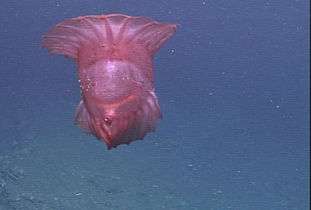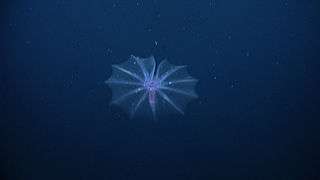Pelagothuriidae
| Pelagothuriidae | |
|---|---|
 | |
| Enypniastes sp. | |
| Scientific classification | |
| Kingdom: | Animalia |
| Phylum: | Echinodermata |
| Class: | Holothuroidea |
| Subclass: | Aspidochirotacea |
| Order: | Elasipodida |
| Family: | Pelagothuriidae Ludwig, 1893 |
| Genera | |
|
(See Text) | |
Pelagothuriidae is a family of deep-sea swimming sea cucumbers. They are somewhat unusual in appearance, in comparison with other sea cucumbers, having numerous appendages, including conical papillae and leaf-like tentacles. Most of them are benthopelagic, which means that they are able to swim for a time from the bottom : the species Pelagothuria natatrix is the only true pelagic holothurian (and echinoderm, to date) ; it looks like a jellyfish. Most members of the order inhabit deep-sea environments, like Enypniastes.[1]
Classification
Family: Pelagothuriidae
- genus Enypniastes Théel, 1882
- genus Pelagothuria Ludwig, 1893

The only true pelagic echinoderm known to date : Pelagothuria natatrix (here close to the Galapagos).
References
| Wikispecies has information related to: Pelagothuriidae |
| Wikimedia Commons has media related to Pelagothuriidae. |
- Barnes, Robert D. (1982). Invertebrate Zoology. Philadelphia, PA: Holt-Saunders International. p. 995. ISBN 0-03-056747-5.
- Mah, Christopher (September 18, 2012). "Deep-Sea Swimming Sea Cucumbers and the "most bizarre holothurian species in existence"!". The Echinoblog.
Notes
- ↑ Mah, Christopher (September 18, 2012). "Deep-Sea Swimming Sea Cucumbers and the "most bizarre holothurian species in existence"!". The Echinoblog.
This article is issued from Wikipedia - version of the 10/31/2014. The text is available under the Creative Commons Attribution/Share Alike but additional terms may apply for the media files.